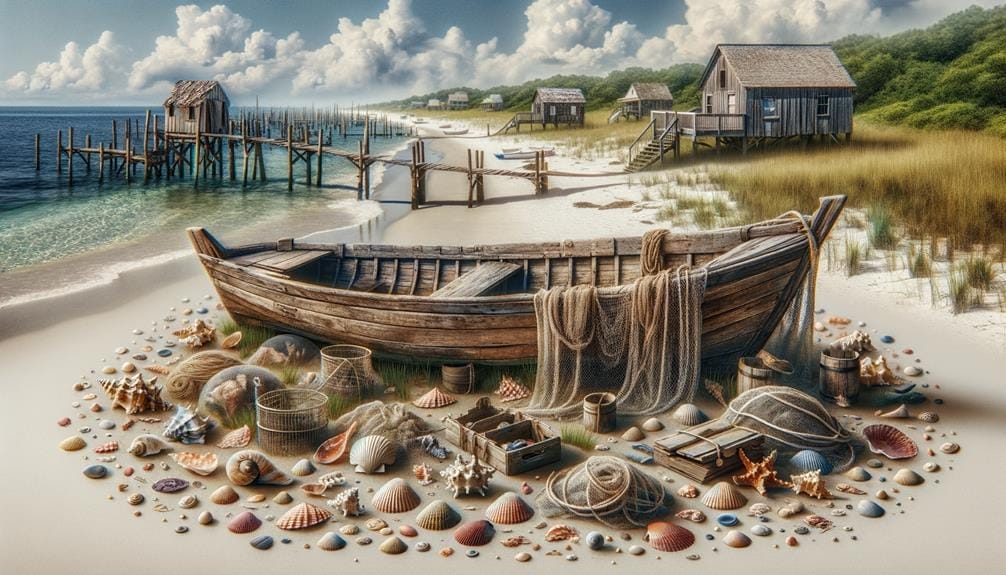Did you know that Grayton Beach has a fascinating history that stretches back to the late 19th century? It all began with Army Major Charles T. Gray, who established his homestead in the area in 1885.
But there’s much more to discover beyond its origins. From the influence of Native Americans to the growth of tourism and the impact of hurricanes, Grayton Beach has seen its fair share of historical events.
So, if you’re curious to uncover the secrets and stories that have shaped this charming coastal community, come along as we explore the intriguing history of Grayton Beach.
Key Takeaways
- Grayton Beach has a significant Native American influence, with tribes like the Muscogee, Creek, and Euchee Indians residing in and around Walton County.
- The town of Grayton Beach was founded in 1890 as a fishing village, supporting the timber industry and thriving as a fishing community due to its proximity to the Gulf of Mexico.
- Tourism has had a major economic impact on Grayton Beach, with increased revenue, job opportunities, and attractions drawing visitors to the area.
- Infrastructure development in the 1930s, including the construction of highways, bridges, and electricity, improved accessibility and paved the way for the growth and development of Grayton Beach.
Early Settlements

Early settlers began to establish their presence in Grayton Beach in the late 19th century, laying the foundation for the community’s future development. Army Major Charles T. Gray played a significant role in the establishment of Grayton Beach when he built his homestead in 1885. This marked the beginning of a small but promising settlement in the area. Despite limited accessibility, with no bridges and sandy trails, the early residents of Grayton Beach persevered and worked towards creating a thriving community.
The state of the land in Grayton Beach posed challenges for construction and development. The sandy terrain made it difficult to build sturdy structures, and the lack of infrastructure hindered growth. However, the determination of the early settlers prevailed, and they managed to build modest homes and community structures.
These early settlements served as the backbone of Grayton Beach’s growth. The residents worked together, supporting one another to overcome the obstacles they faced. Their hard work and dedication laid the groundwork for the future development of Grayton Beach as a popular vacation retreat. The community’s resilience and unity continue to shape the character of Grayton Beach to this day.
Native American Influence
Native American influence has played a significant role in shaping the cultural heritage of Grayton Beach and surrounding areas. The Muscogee, Creek, and Euchee Indians who inhabited this region in the 1700s and 1800s have left a lasting impact on the community.
Today, the Muscogee Nation of Florida continues to preserve its language, culture, and way of life, showcasing its tribal heritage through crafts and the work of its elders.
Tribal Cultural Heritage
The influence of Native American culture can be seen in the rich traditions and cultural diversity of Walton County. The Muscogee, Creek, and Euchee Indians once inhabited the area in the 1700s and 1800s, and their tribal cultural heritage has left a lasting impact on the region.
Grayton Beach, located in this county, holds significant historical importance. The land at Topsail, near Grayton Beach, was occupied by the Muscogee Nation of Florida. Moreover, Fort Washington, established in the early 1800s, played a crucial role in protecting the region and maintaining peace with the local Native American tribes.
Point Washington on Choctawhatchee is another area where Native American influence can be observed. Army Generals William Miller and Thomas Sidney Jesup had interactions with the local tribes here.
Today, Choctawhatchee Electric Cooperative serves as a reminder of the Native American heritage in the area. The name pays homage to the Choctawhatchee tribe that once resided here.
Indigenous Settlement Patterns
Indigenous settlement patterns in the area reveal a rich tapestry of Native American influence, shaping the cultural landscape of Walton County. Dating back to the 1700s and 1800s, the Muscogee, Creek, and Euchee Indians resided in and around Walton County.
Today, the Muscogee Nation of Florida actively preserves their language, culture, and way of life, showcasing their heritage through crafts and elder traditions at their historic schoolhouse.
Evidence of early Indigenous settlement patterns can be found in the historical towns of the region, where artifacts and remnants of Native American presence still exist. The Choctawhatchee Electric Cooperative brought electricity to the area. Still, it’s important to note that the federal government owned much of the land until Captain Charles Gray built his homestead in Grayton Beach.
The continued Native American influence adds to the cultural diversity and natural heritage of Walton County.
Fishing Village Origins
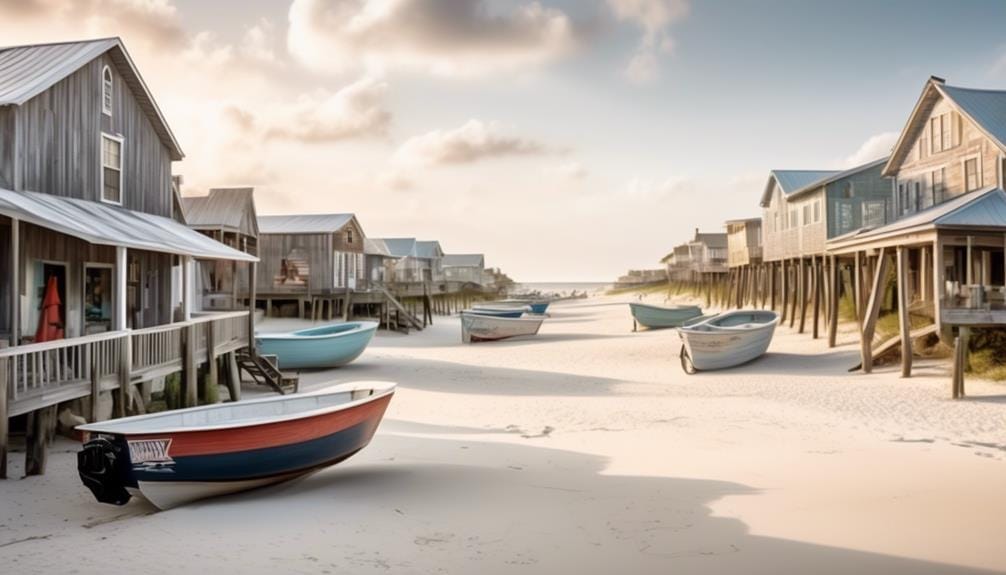
Founded in 1890 by Army Generals William Miller and William Wilson, Grayton Beach has a rich history as a fishing village. The town was initially established as a railway town with the purpose of providing transportation for the timber industry. However, it quickly evolved into a thriving fishing community due to its proximity to the Gulf of Mexico and the abundance of fish in the area. The table below highlights the origins of the fishing village of Grayton Beach and how it has transformed into the Grayton Beach we know today.
| Fishing Village Origins | Grayton Beach Today |
|---|---|
| – Founded in 1890 by Army Generals William Miller and William Wilson. | – Grayton Beach State Park, established in 1967, protects the natural character of the area. |
| – Access to Grayton Beach improved in the 1930s with the construction of highways and bridges. | – Grayton Beach is a village located in the center of a 20-mile-long stretch of coastal dune lakes. |
| – The town was primarily a fishing community due to its proximity to the Gulf of Mexico. | – Grayton Beach offers beach and dune lake access for boating, kayaking, and paddleboarding. |
Over the years, Grayton Beach has seen significant changes. While it started as a small fishing village, it has transformed into a popular tourist destination known for its stunning beaches and unique coastal dune lakes. The town founder’s vision of creating a railway town has evolved into the establishment of Grayton Beach State Park, ensuring the preservation of the area’s natural beauty. Today, Grayton Beach continues to attract visitors and residents alike, who appreciate its rich history and its thriving ecosystem.
Growth of Tourism
As tourism began to grow in Grayton Beach, the number of visitors to the area increased significantly.
This rise in visitor numbers had a substantial economic impact on the local community, attracting more businesses and stimulating the local economy.
To accommodate the influx of tourists, infrastructure development became a priority, with the construction of highways, bridges, and waterways making the area more accessible and appealing to visitors.
Rise in Visitor Numbers
Has the rise in visitor numbers to Grayton Beach been attributed to specific factors?
The growth of tourism in this small town in the Florida Panhandle can be attributed to several key factors.
Firstly, the construction of Highway 98, the 331 bridge, and the Intracoastal waterway in the 1930s greatly increased accessibility to Grayton Beach, attracting more visitors and property buyers.
Additionally, the establishment of Grayton Beach State Recreation Area in 1967 aimed to protect the town’s character, further attracting tourists.
Preservation efforts, such as preventing land development and creating conservation areas, have also played a role in attracting visitors who appreciate Grayton Beach’s natural heritage.
Moreover, the town offers a range of attractions and activities, including beach and dune lake access, traditional Florida cracker-style homes, and a popular state park for outdoor enthusiasts.
As a result, the rise in visitor numbers to Grayton Beach can be attributed to a combination of improved accessibility, preservation efforts, and the town’s unique attractions.
Economic Impact of Tourism
Tourism in Grayton Beach has had a significant economic impact, contributing to the town’s thriving economy. The rise in visitor numbers has played a crucial role in the growth of the tourism industry, leading to increased revenue and job opportunities.
Grayton Beach’s annual events and festivals, showcasing its rich heritage, have attracted visitors from near and far, boosting the local economy. Furthermore, the town’s cultural and historical attractions have been instrumental in drawing tourists to the area.
The preservation efforts and state-protected land have helped maintain Grayton Beach’s small size and rich natural heritage, making it an attractive destination for eco-tourists.
Infrastructure Development
After discussing the economic impact of tourism in Grayton Beach, it’s important to examine the crucial role that infrastructure development has played in the growth of the town’s tourism industry.
In its early days, Grayton Beach faced limited accessibility with no bridges and sandy trails. This hindered its growth as a vacation retreat. However, in the 1930s, infrastructure development took place, including the construction of highways and bridges and the introduction of electricity. These improvements led to increased accessibility, attracting more visitors to the area.
Notably, the creation of the Grayton Beach State Recreation Area in 1967 aimed to preserve the town’s character amidst growing development pressures. Today, Grayton Beach’s appeal lies in its attractions and activities, such as beach and dune lake access, traditional Florida cracker-style homes, and a popular state park, all made possible by the infrastructure development that has shaped its growth.
Impact of Hurricanes
The impact of hurricanes on Grayton Beach has been significant, causing destruction to historic buildings and altering the landscape over the years. The 1926 hurricane, for instance, destroyed Major Gray’s former home, The Grayton Inn, a structure that held great historical value for the area. Additionally, a portion of the dunes at the beach were washed away, changing the natural features of Grayton Beach. Hurricane Opal in 1995 also left its mark, causing flooding and damage that affected the development and preservation efforts of the area.
The construction of Highway 98 and the 331 bridge, made accessible after natural disasters, has attracted more visitors and property buyers to Grayton Beach. This influx of people has contributed to the area’s history and settlement, shaping the community in new ways.
Conservation efforts have played a crucial role in protecting Grayton Beach from the impact of hurricanes and other natural disasters. The creation of the Grayton Beach State Recreation Area in 1967 and the acquisition of additional land for preservation have helped safeguard the area’s natural heritage and maintain its attractions and activities.
Despite the challenges hurricanes pose, Grayton Beach has managed to preserve its historical and natural significance through the dedication of its residents and the implementation of conservation measures. This resilience has allowed the area to continue flourishing as a unique coastal destination.
Development of Infrastructure
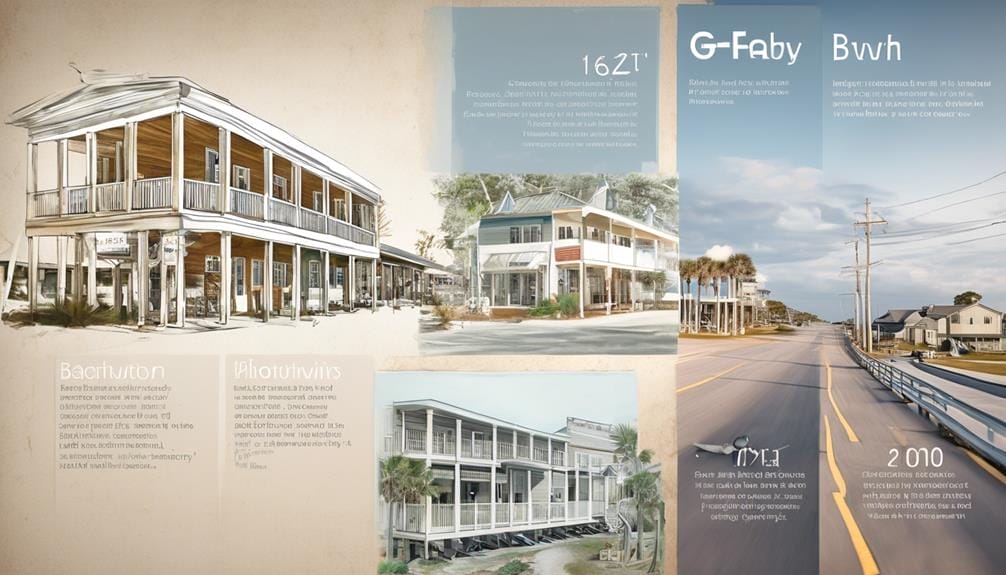
Improved accessibility and the establishment of essential amenities have played a pivotal role in the development of Grayton Beach’s infrastructure. Over the years, various measures have been taken to enhance transportation and provide basic services to the community. The construction of highways and bridges, along with the introduction of electricity, have significantly contributed to the growth and convenience of Grayton Beach.
One of the notable developments in infrastructure was the construction of Highway 98, which improved access to and from Grayton Beach. This highway serves as a major route connecting the village to neighboring areas, facilitating the movement of residents and visitors. Additionally, the construction of the Highway 331 bridge and the Intracoastal Waterway further enhanced connectivity and accessibility in the region.
In the 1940s, the Choctawhatchee Electric Cooperative brought electricity to Grayton Beach, transforming the lives of its residents. The availability of electricity enabled the establishment of businesses, improved living conditions, and supported the growth of the community.
Furthermore, the establishment of the U.S. Coast Guard station in Grayton Beach in 1942 contributed to the development of infrastructure and provided additional security to the area.
The Grayton Beach State Recreation Area was created in 1967 to protect the unique character of Grayton Beach. This state park ensured the preservation of the natural environment and allowed visitors to enjoy the beauty of the area while maintaining its infrastructure.
In 1985, Florida purchased beachfront, dunes, and forest land in Grayton Beach, further securing the conservation of the area and supporting the development of infrastructure.
The table below summarizes the key developments in Grayton Beach’s infrastructure:
| Infrastructure Development | Year |
|---|---|
| Construction of Highway 98 | N/A |
| Construction of Highway 331 bridge | N/A |
| Introduction of electricity by Choctawhatchee Electric Cooperative | 1940s |
| Establishment of U.S. Coast Guard station | 1942 |
| Creation of Grayton Beach State Recreation Area | 1967 |
| Purchase of beachfront, dunes, and forest land by Florida | 1985 |
These developments have been instrumental in shaping Grayton Beach’s infrastructure, providing the necessary foundation for the community’s growth and ensuring the accessibility and convenience of its residents and visitors.
Environmental Conservation Efforts
With the foundation of Grayton Beach’s infrastructure firmly established, it’s now imperative to shift our focus towards the environmental conservation efforts that have been integral in preserving the area’s rich natural heritage.
Grayton Beach State Recreation Area, created in 1967, was the first step taken to protect the character of Grayton Beach. This state park encompasses beachfront, dunes, and forest land, providing a sanctuary for the diverse flora and fauna that call this area home.
In 1985, the state of Florida further solidified its commitment to conservation by purchasing additional land in Grayton Beach, including the beachfront, dunes, and forests. This acquisition ensured the preservation of the area’s natural state and prevented any potential development that could harm the fragile ecosystem.
Moreover, the failed land swap attempt for Topsail Hill in the same year demonstrated the dedication of both the state and the community to maintaining the integrity of Grayton Beach.
These collective efforts, driven by a shared appreciation for the rich natural heritage of Grayton Beach, have successfully safeguarded the area’s environmental well-being.
Notable Historical Events
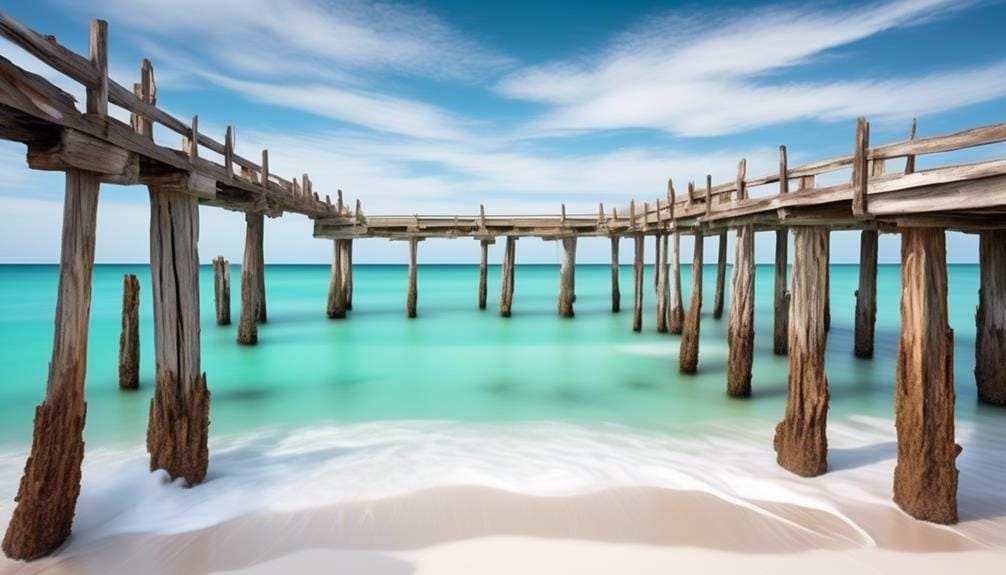
As you explore the notable historical events of Grayton Beach, you’ll discover key moments that have shaped its history.
From the founding of the village in 1890 by Army Generals William Miller and William Wilson to the destruction caused by the hurricane of 1926, these events have had a significant impact on the landscape and development of Grayton Beach.
Additionally, the discovery of a 4-billion-year-old meteorite on the beach and the subsequent preservation efforts highlight the historical significance of this coastal area.
Key Events
Throughout its history, Grayton Beach has experienced several key events that have shaped the town’s development and character.
In 1890, Army Generals William Miller and William Wilson founded Grayton Beach, establishing a fort to protect the area.
The devastating Hurricane of 1926 reshaped the beach, washing away the Grayton Inn and flattening the beach for car access, changing the landscape of the town.
The implementation of President Franklin D. Roosevelt’s New Deal in the 1930s led to the construction of Highway 98, the 331 bridge, and the Intracoastal Waterway, making Grayton Beach more accessible to visitors and residents.
These events played a crucial role in the growth and preservation of Grayton Beach, ensuring its place as a unique and cherished destination along the Florida coast.
Significance and Impact
The notable historical events surrounding Grayton Beach have had a significant impact on the town’s development and reputation as a cherished destination along the Florida coast.
In its early days, Grayton Beach faced limited accessibility, hindering its potential as a vacation retreat. However, the construction of Highway 98, the Highway 331 bridge, and the Intracoastal Waterway in the 1930s greatly improved accessibility, attracting more visitors and property buyers to the area.
Preservation efforts also played a crucial role in shaping Grayton Beach’s history. The creation of the Grayton Beach State Recreation Area in 1967 ensured the town’s character was preserved against excessive development. Additionally, the discovery and subsequent removal of a 24lb, 4-billion-year-old meteorite just before the state took control of the beach and park had a notable impact.
Today, Grayton Beach’s natural beauty, with its beach and dune lake access, continues to draw outdoor enthusiasts, solidifying its reputation as a cherished destination.
Historical Figures
During the notable historical events surrounding Grayton Beach, several figures emerged that played a significant role in shaping the town’s development and reputation as a cherished destination.
These historical figures include:
- Army Major Charles T. Gray: In 1885, Major Gray built his homestead, which led to the founding of the village of Grayton Beach. His presence and influence laid the foundation for the town’s growth and prosperity.
- Preservationists: Over the years, dedicated individuals and organizations have worked tirelessly to protect Grayton Beach’s natural beauty and charm. Their efforts, including the creation of Grayton Beach State Recreation Area in 1967, have ensured the preservation of this coastal paradise for future generations.
- Settlers and Pioneers: The early settlers and pioneers of Grayton Beach played a crucial role in the town’s history. They braved the challenges of limited accessibility, sandy trails, and a rugged environment to establish a community that would thrive and evolve into the beloved coastal village we know today.
These historical figures have left an indelible mark on Grayton Beach, shaping its history and contributing to its enduring allure as a cherished destination in Florida.
Cultural Significance
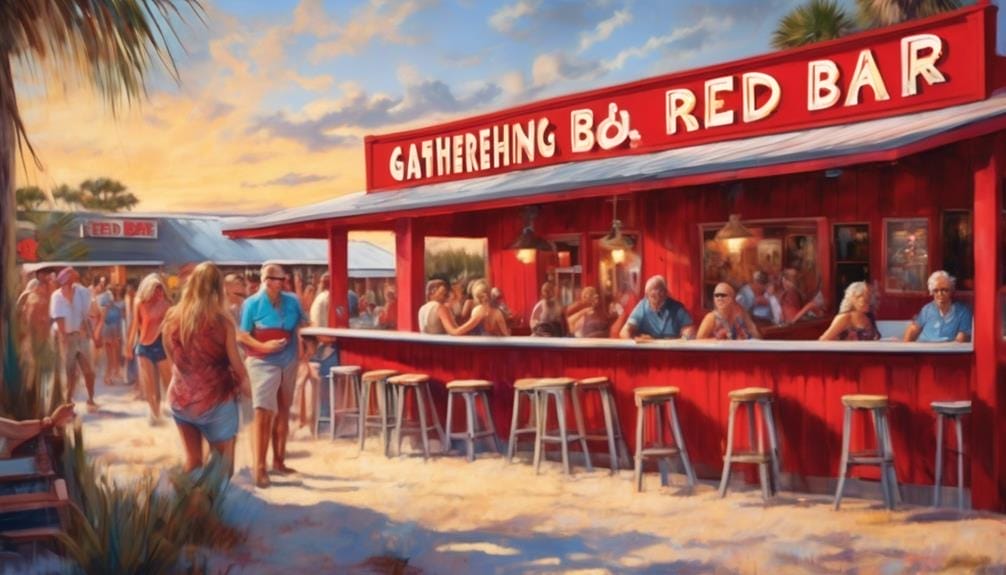
With its rich history of early settlement and development, Grayton Beach’s cultural significance is evident in the establishment and growth of the village, as well as its preservation efforts. The beach residents have played a crucial role in shaping the town’s character and maintaining its unique cultural heritage. Over the years, they’ve been actively involved in lobbying for the preservation of Grayton Beach’s natural beauty and advocating for responsible development.
The cultural significance of Grayton Beach can be seen in the preservation of its traditional Florida cracker-style homes, which serve as a reminder of the area’s past. These homes, along with the friendly dogs that roam the village, contribute to the town’s charm and sense of community. Additionally, the popular state park in Grayton Beach attracts visitors from near and far, showcasing the area’s natural beauty and providing opportunities for outdoor activities.
Grayton Beach’s cultural significance isn’t limited to its physical attributes. The village holds a unique meteorite discovery and preservation story, adding to its historical narrative. This discovery hasn’t only fascinated scientists but has also captivated the imagination of locals and visitors alike.
Situated in a unique geographical setting, Grayton Beach is surrounded by coastal dune lakes, state parks, and a rich natural heritage. This natural landscape adds to the town’s cultural significance, providing a backdrop for residents and visitors to appreciate and enjoy.
In a world that’s increasingly urbanized and disconnected from nature, Grayton Beach stands as a reminder of the importance of preserving our natural environment and cultural heritage.
Preservation and Restoration
As we shift our focus to the subtopic of preservation and restoration, let’s explore the efforts made by Grayton Beach residents to safeguard the town’s unique cultural heritage and natural beauty.
Grayton Beach State Recreation Area, established in 1967, was a significant step towards protecting the character of Grayton Beach. Additional land was later acquired to safeguard the area further, ensuring its preservation for future generations.
Residents, such as Bet Haynes, played a crucial role in defending the town against developers who sought to exploit its natural resources. In 1974, residents took decisive action when earthmoving equipment was discovered on the beach, effectively putting a stop to any development plans.
However, recent disputes have arisen regarding the tearing down of older homes to make way for larger rental properties, prompting ongoing conversations about the balance between preservation and progress.
These efforts highlight the dedication of Grayton Beach residents to preserving the town’s history and maintaining its unique charm. Through their advocacy and actions, they strive to protect the natural beauty and cultural significance of Grayton Beach for generations to come.
Grayton Beach Today
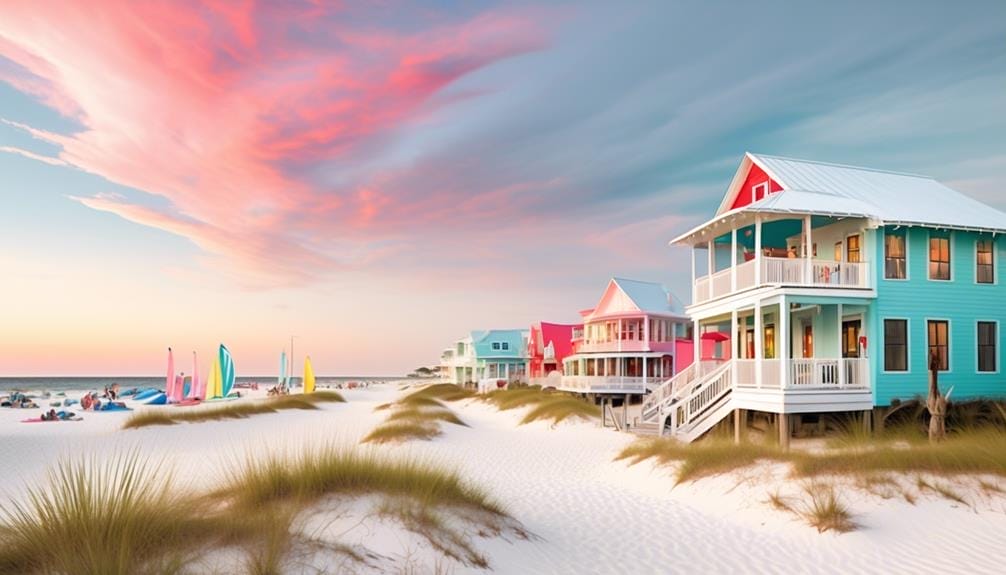
Grayton Beach, a picturesque coastal town in Florida, has undergone significant changes over time while still maintaining its unique charm and neighborhood feel.
Today, Grayton Beach is a popular destination for outdoor enthusiasts, offering beach and dune lake access for boating, kayaking, and paddleboarding. The area is known for its traditional Florida cracker-style homes and the friendly dogs that can be seen lying flat out on the road.
Grayton Beach State Park, located in the center of a 20-mile-long stretch of coastal dune lakes, is a major attraction for visitors. The park offers a range of activities and attractions, including hiking trails, picnicking areas, and opportunities to observe native wildlife.
In recent years, Grayton Beach has seen an increase in accessibility with the addition of traffic lights and signs. The town has also welcomed new restaurants and stores, further enhancing its appeal to both locals and tourists.
Despite these changes, Grayton Beach has managed to preserve its neighborhood feel and maintain its connection to its Native American history. In the north, the Beach State Recreation Area offers a serene environment, making it the perfect place to relax and enjoy the natural beauty of Grayton Beach.
Frequently Asked Questions
What Is Grayton Beach Known For?
Grayton Beach is known for its natural beauty, emerald waters, and coastal dune lakes. It’s a quaint beach town where you can enjoy outdoor activities like boating and kayaking. Don’t forget to try the local seafood!
Who Owns Grayton Beach?
When discussing property ownership in Grayton Beach, it is important to note that both public and private ownership exist. There have been disputes regarding ownership rights, particularly in regard to tearing down older homes for larger rental properties.
What Was the First Beach on 30a?
The first beach on 30A was Grayton Beach. Despite limited accessibility and sandy trails, early settlers recognized its potential as a vacation retreat. Today, it stands as a testament to coastal preservation and offers a rich history, from Native American roots to popular tourist attractions.
What Is the Slogan for Grayton Beach?
The slogan for Grayton Beach is ‘Nice dogs, strange people.’ It perfectly captures the laid-back and quirky atmosphere of the community. Grayton Beach is known for its dog-friendly environment, diverse residents and visitors, and welcoming spirit.
Conclusion
You may think that Grayton Beach is just another picturesque seaside town with a charming history. But beneath its idyllic facade lies a story of resilience and transformation.
From its humble beginnings as a remote and inaccessible settlement, Grayton Beach has evolved into a thriving tourist destination. Its journey, marked by the construction of highways and the impact of hurricanes, reveals a tale of adaptability and the enduring spirit of the community.
Today, Grayton Beach stands as a testament to the power of nature and the determination of its people.

